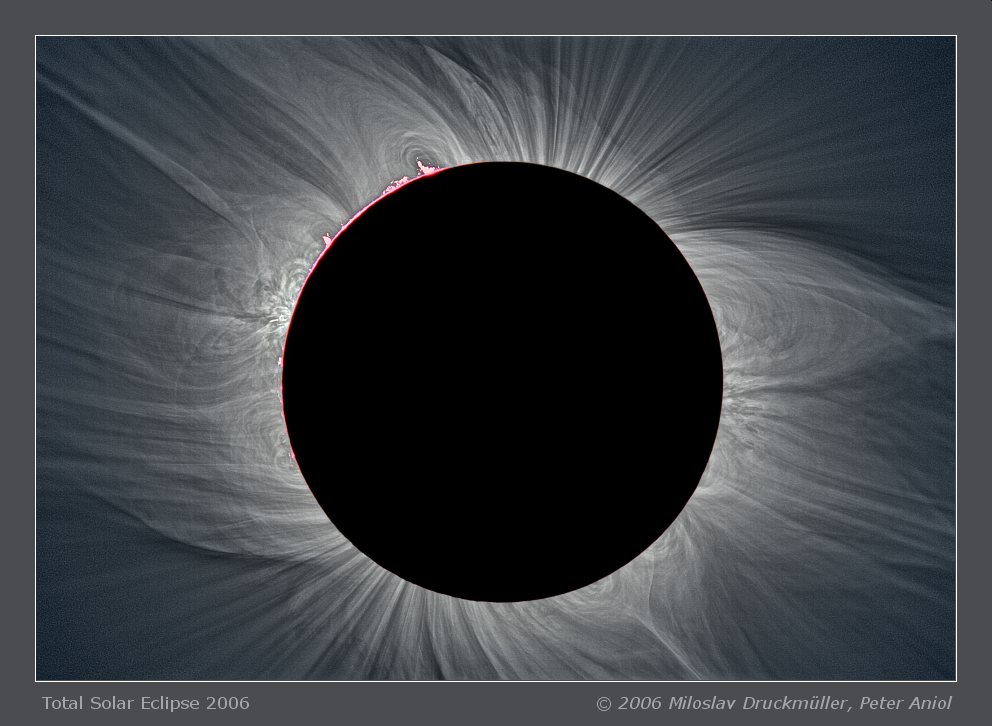

Solar physicists attempting to unlock the mysteries of the solar corona have found another piece of the puzzle by observing the sun’s outer atmosphere during eclipses. This is the first such map of the 2-D distribution of coronal electron temperature and ion charge state. Red indicates iron line Fe XI 789.2 nm, blue represents iron line Fe XIII 1074.7 nm, and green shows iron line Fe XIV 530.3 nm. This image of the solar corona contains a color overlay of the emission from highly ionized iron lines and white light taken of the 2008 eclipse. The colored circles indicate localized enhancements in Fe XI that have no correspondence in white light, while the bubble structure surrounding the yellow circled region is barely distinguishable in white light. Credit: Habbal, et al.Ĭomparison of the first image of the corona in Fe XI 789.2 nm, taken during the 2006 eclipse, with a white-light image taken by Miloslav Drückmuller from Brno University of Technology in the Czech Republic. These are the first such maps of the 2-D distribution of coronal electron temperature and ion charge state. Reference: “Coronal Magnetic Field Topology from Total Solar Eclipse Observations” by Benjamin Boe, Shadia Habbal and Miloslav Druckmüller, 3 June 2020, The Astrophysical Journal.These images of the solar corona are color overlays of the emission from highly ionized iron lines for the 2006 eclipse (left column) and 2008 eclipse (right column), with white-light images added in the bottom row. The next one is slated for South America in December 2020.
#SUN CORONA 2006 ECLIPSE HOW TO#
It indicates that the leading ideas for how to model the formation of the solar wind are not complete, and so our ability to predict and defend against space weather can be improved,” Boe said.īoe is already planning to be part of the Solar Wind Sherpas’ next eclipse expeditions. “These results are of particular interest for solar wind formation. This work has further implications in other areas of solar research-including the formation of the solar wind, which impacts the Earth’s magnetic field and can have effects on the ground, such as power outages. Instead, this work found that the coronal field was often non-radial to at least 4 solar radii. These results challenge the current assumptions used in coronal modeling, which often assume that the coronal magnetic field is radial beyond 2.5 solar radii. “Future models will have to explain these features in order to fully understand the coronal magnetic field.” “We knew there would be changes over the solar cycle but we never expected how extended and structured the coronal field would be,” Boe explained.

During periods of maximum, the coronal magnetic field was far less organized and more radial. To quantify these changes, Boe measured the magnetic field angle relative to the Sun’s surface.ĭuring periods of minimum solar activity, the corona’s field emanated almost straight out of the Sun near the equator and poles, while it came out at a variety of angles at mid-latitudes. Higher resolution images showed smaller-scale structures, implying that the corona is even more structured than what was previously reported. This data provided the chance to study changes in the corona over two 11-year magnetic cycles of the Sun.īoe found that there were very fine-scale structures throughout the corona. Boe/UH Institute for Astronomyīoe traced the pattern of the distribution of magnetic field lines in the corona, using an automatic tracing method applied to images of the corona taken during 14 eclipses the past two decades. Top panels show the visible light (color inverted), lower panels show the magnetic field shape. High-resolution images of the solar corona.


 0 kommentar(er)
0 kommentar(er)
